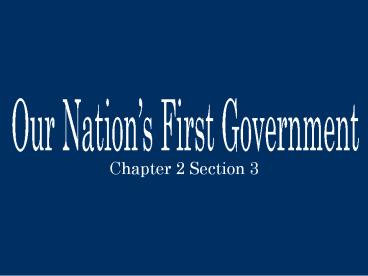Chapter 2 Section 3 PowerPoint PPT Presentation
1 / 8
Title: Chapter 2 Section 3
1
Our Nations First Government
- Chapter 2 Section 3
2
I. State Constitutions
- Constitution written plan for government
- By 1780, each state had a constitution, a
bicameral legislature, a governor to enforce
laws, and a court system to interpret laws. Some
states had a Bill of Rights to protect individual
rights.
3
C. Massachusetts Constitution
- It was the basis for the U.S. Constitution.
- It distributed power among a Legislative Branch,
Executive Branch, and Judicial Branch. - The governor and the courts were able to limit
the power of the legislature. - The Massachusetts Constitution was written during
a convention and approved by Massachusetts'
citizens.
4
II. Articles of Confederation, 1777
- The colonies were afraid of a powerful
centralized government, but they could not
survive as individual countries. - The colonies formed a Confederation or a League
of Friendship called the Articles of
Confederation. - The colonists did not want a strong government
because they were afraid the government would
abuse its power!
5
III. Weaknesses in the Articles of
Confederation Governmentrefer to the diagram
on page 41 (I-books pg.16)
- Congress could not pass a law unless nine states
voted in favor of the law. - The government had no power to regulate trade
between states. - To amend the Articles of Confederation, all of
the 13 states had to approve. - There was no executive branch or judicial branch.
- The federal government could not tax or demand
money from state governments.
6
- IV. 1783 Treaty of Paris
- A. The peace agreement between Great
- Britain and the United States that
- ended the Revolutionary War.
- B. Great Britain recognized the United
- States as an independent country.
- V. War Debt
- A. The Articles of Confederation
- government was deeply in debt
- because of the Revolutionary War. The
- government raised taxes to pay off the
- debt. The colonists were hurt badly by
- the taxes, especially the farmers.
7
VI. Shays Rebellion
- Daniel Shays was a Massachusetts farmer. The
courts tried to take his farm because he could
not pay the new taxes. - He led a rebellion of 1,200 farmers onto a
federal arsenal. The rebellion was stopped by
colonial militia because the Articles of
Confederation Government was not strong enough to
stop the rebellion.
8
- VII. The Constitution
- In 1787, twelve states sent delegates to a
meeting in Philadelphia. They were supposed to
revise the Articles of Confederation Government. - The delegates chose to throw out the Articles of
Confederation and create the Constitution, though
they were only authorized to change the Articles
government.

